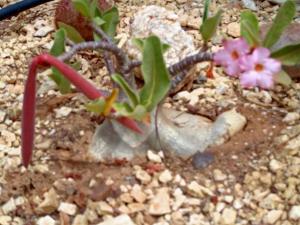The majority of people buying cacti and other succulents don’t really care if their purchased plants die after some time; they just buy a replacement. These are fortunately not our customers (and that is very un-commercial!!!).
The real passionate gardener, hobbyist, etc. buys with the intention to enjoy his/her plants for a long time. These are the people we like to welcome in our nursery and they are invited to be critical and during many of such occasions we experience an educational interaction to the benefit of all.
First something about our own experience. In the beginning (we didn’t know that much about the subject and we are still learning) we bought quite a few Aloes at one of the botanical gardens in the Western Cape. The plants were nicely labeled with with their full botanical names. Almost all turned out to be hybrids. At a specialist succulent nursery we bought 12 cacti of which 8 had a ‘hidden’ (underground) disease.
Botanists are in continuous discussion with each other about botanical names and during identification of certain group (genus) of plants. The Aloes are very good example because these hybridise easily and proper identification, in case of doubt, can only be done with DNA-research. THE Haworthia ‘specialist’ of South Africa is very honest when he says that he is unable to generate a proper identification key which covers all Haworthias and that he has difficulties to identify some of the Haworthia-species. With other words: don’t always be too sure about about the botanical names with which plants are labeled. Another issue is that many botanical names are changing nowadays because of DNA-research (f.e. part of the Stenocereus species becomes suddenly Cleistocactus or whatever) and that makes it even more complicated. A self-respecting nursery man will, in case of doubt, always label ‘spp’ after the genus name; f.e. ‘Mammillaria spp.’
How can one check if the plants are healty? This is not always easy but you can take some precautions. Is the nursery clean, relativily weed free and do the plants, on first sight, look healthy? This is the first impression. If the first impression is not good be extra critical.
Some hidden diseases are difficult to identify such as roots which start to rot at their tips. Even if the plants look healthy but you see that they are waterlogged (and not just after a heavy rainfall) be critical. Some nurseries use quite a few fertilisers,pesticides, fungicides and so on to let the plants look healthy but once purchased you will have to apply these chemicals until you are pretty sure that they are adapting to your preferred way of gardening. Once we were at a succulent nursery where the plants were covered with a blue layer caused by the application of copper sulphate.
Golden tip, which prevents you in at least 70 percent of such cases of ‘buying a cat in a bag’, is removing the soil around the neck of the plant. If the tissue is not soft(ening) but feels solid the plant might be healthy. This applies surely for all Aloes, Caudiciforms (especially adenium- adenia- and cyphostemma sp., Lithops, Cacti and cacti-like Euphorbias.
Almost at last but certainly not at least: Most nurseries sell their plants from under a roof or shade net. Advise (especially in Summer): Don’t put the plant right away under the sun, once at home. Let the plant slowly get adepted to the sun. This can be done by providing the plants with morning sun and afternoon shade for the first few days and let them gradually stay longer in the sun until, after a week or so, they are used to the sun. Some plants, amongst others Echinocactus crussonii (Golden Barrel Cactus or Mother’s in Law Seat) need sun protection for the first year until they are established. Keep the plant covered with a shade net (at least between 12 and 4 PM) from the second half of December to the second half of March. A good nursery with in-house knowledge will give you decent information. If the
Damage on a plant caused by snails and (scale-)insects are in general not terminal and can even give the plant a natural charm. In nature you won’t find that many plants (=relatively) which are looking perfect. On the contrary but these plants are strong with some build in resistance.
 Lophocereus species. Keep you updated.
Lophocereus species. Keep you updated.





